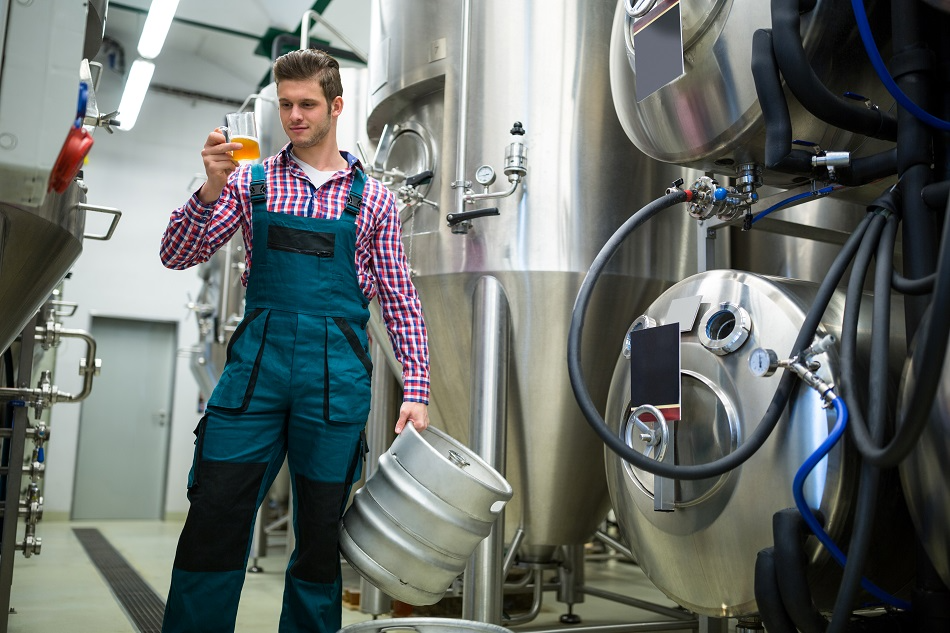An abundance of chemical reactions can be present in breweries. From fermentation to drying to filtration, most steps of the brewing process include different chemistries and, in some examples, the creation of gases. While most of these gases may not be highly toxic alone, significant volumes of them can present substantial health and safety hazards and require the use of considerable gas monitoring equipment in breweries.

Image Credit: wavebreakmedia/Shutterstock.com
The process of fermentation is one of the main reaction stages in the creation of alcoholic products. The final flavor profile of the product is affected by the concentrations of chemical side products created through this reaction1 and the fermentation speed affects the total concentration of ethanol in the final product.2
Fermentation happens in anaerobic or oxygen-deficient conditions. In these environments, ethanol is produced when yeast breaks down glucose in the brewing mixture, and carbon dioxide is released as a side product. Smaller amounts of methane gas and hydrogen may also be emitted.
While employees are unlikely to encounter the anaerobic conditions of a closed fermentation vat, large quantities of carbon dioxide could be released if a leak occurs in the vessel.
A leak can easily be overlooked as the gas is colorless and odorless. Open fermentation vessels pose more of a threat because the headspace above these vessels can reach significantly high concentrations of carbon dioxide.3
Nausea and dizziness can be caused by carbon dioxide at low concentrations, but higher concentrations can lead to death by asphyxiation (from oxygen displacement), which is why it is a legal requirement to have gas monitoring equipment in locations where carbon dioxide is produced or used.4
Along with the complexity of noticing leaks when they occur, carbon dioxide is especially dangerous as an asphyxiant because it is denser than oxygen. Carbon dioxide gathers in low-lying areas and displaces the oxygen there. This means that lower level or basement areas can still be vulnerable to small leaks, even if the surroundings of the fermentation tank are unaffected.
Gas Detection or Depletion?
There are numerous ways to comply with the health and safety guidelines related to carbon dioxide production. Gas detectors can be used to monitor the concentration of a specific gas, or oxygen depletion sensors can be used.
Sensors are usually created to detect only one type of gas, while gas monitors can be beneficial for the detection of leaks. It may be more suitable to use oxygen depletion sensors in breweries, as the main hazard is normally asphyxiation due to a lack of oxygen.
Oxygen depletion sensors trace the levels of oxygen in gases (or in this example, the room air) and are normally configured to a type of alarm system that triggers when the oxygen level falls below a threshold.
There are various types of oxygen depletion monitors. Some sensors, such as the zirconium oxide oxygen sensors, require the presence of a reference oxygen sample to function accurately. The oxygen reference gas can sometimes be produced in situ, but a number of sensors depend on an external gas feed for refilling.5
Oxygen References
Not all breweries are necessarily equipped for the safe handling and storage of heavy, large pressurised gas cylinders either. Non-refillable, small gas cylinders such as the ones created by Air Products are an attractive alternative to large cylinders.6
They are supplied in small volumes (down to 34, 58, and 110 Gaseous litres) and to provide the most accurate reference measurements, gas is available at the high specifications required.
Along with being easier to handle and more portable, canisters from Air Products are a good way of eliminating the health and safety hazards that are posed by the storage of large cylinders and the related expenses.
This decreases the hassle of refilling oxygen depletion sensors, which are an integral element of safety at any brewery location, along with promoting a safer workplace, with no requirement to implement more specialised safety equipment for gas handling at a large scale.
References and Further Reading
- Chambers, Paul J., and Isak S. Pretorius. 2010. “Fermenting Knowledge: The History of Winemaking, Science and Yeast Research.” EMBO Reports 11(12): 914–20.
- Carlsen, H. N., H. Degn, and D. Lloyd. 1991. “Effects of Alcohols on the Respiration and Fermentation of Aerated Suspensions of Baker’s Yeast.” Journal of General Microbiology 137(12): 2879–83.
- Kobayashi, Michiko et al. 2005. “On-Line Estimation and Control of Apparent Extract Concentration in Low-Malt Beer Fermentation.” Journal of the Institute of Brewing 111(2): 128–36.
- HSE on CO2, (2019) http://www.hse.gov.uk/carboncapture/carbondioxide.htm, accessed 20/02/2020
- Kimura, Shinji, Shigeo Ishitani, and Hirosh Takao. 1986. “Principles and Development of a Thick-Film Zirconium Oxide Oxygen Sensor.” ACS Symposium Series 2: 101–20.
- Air Products Calibration Gas Cylinders (2019), https://www.shopairproducts.co.uk/category.php?category_id=18, accessed 20/02/2020

This information has been sourced, reviewed and adapted from materials provided by Air Products PLC.
For more information on this source, please visit Air Products PLC.